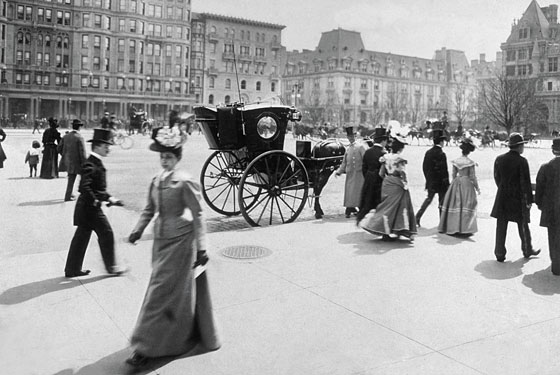
What better time to have been a New Yorker? On January 1, 1898, the consolidation plan went into effect, joining the largest city in the nation (Manhattan) with the fourth-largest (Brooklyn) and throwing in Queens, Staten Island, and the Bronx for good measure. A huge crowd gathered in Union Square and marched down to City Hall, celebrating with fireworks and floats. Though some Brooklynites mourned their loss of municipal identity, the amalgamation had been inevitable ever since the opening of the Brooklyn Bridge, in 1883. Expansion was the order of the day: That same year, the United States annexed the Philippines, Guam, Puerto Rico, and Hawaii. A beefed-up New York was now primed to become America’s imperial city, dazzling the world.
In keeping with this self-conscious sense of global destiny, the city was now awash in institutions of neoclassical Roman grandeur: The Metropolitan Museum of Art, the New York Public Library, the Brooklyn Museum, and Columbia University were in various stages of construction. It was a great time for the wealthy, the so-called Four Hundred who could fit into Mrs. Astor’s ballroom. The city had finally recovered from the 1893 recession, and the economy was on the rise.
If you went down into the streets, you would see that clash of ugliness and beauty, comfort and inconvenience, elegance and grit that would become the New York aesthetic and that Alfred Stieglitz was documenting in photographs. Immigrants, especially Italians and Jews, were pouring in, bringing a cosmopolitan flavor to street life and alarming Anglo-Saxon nativists. Realist writers such as Stephen Crane and William Dean Howells were injecting harsh truths into the decorous minds of middle-class readers.
The era came to be called the Gay Nineties because of its ostentatious emphasis on fun; it was called the Mauve Decade because of its Wildean “decadence” and openness to license. There was plenty of entertainment, as New York City had begun marketing itself as America’s show-business and media capital. You could go to vaudeville shows or see Edison’s movies at kinetoscope parlors; you could watch Lillian Russell in operettas by Victor Herbert, when she was not being squired around by Diamond Jim Brady; you could root for prizefighters like Bob Fitzsimmons, Gentleman Jim Corbett, and James Jeffries. A popular song like “Sidewalks of New York” sold millions of sheet-music copies.
New York’s port was in the midst of an ambitious improvement project. J. P. Morgan ruled the financial world; Tammany’s canny boss Richard Croker ran the city’s politics. Smooth going all around. Of course, there was vast misery in the tenements and sweatshops; tuberculosis, syphilis, and alcoholism were rampant, the rivers polluted with sewage. But even this gave rise to the reformist activism of Emma Goldman and Jacob Riis. So in the end, everyone was happy in 1898 New York City, and you’d have been too.